In response to surging demand for high-capacity chemical packaging, SFXB (Xuebapack) engineered a custom 6000 bottles/hour (1 L) bleach filling line. This turnkey system – from bottle unscrambler through anti-corrosion filler, capping, labeling and conveyor – was specifically designed to handle corrosive sodium hypochlorite safely and efficiently. Sodium hypochlorite solutions (bleach) are highly corrosive to common metals like stainless steel and aluminum, so meeting the customer’s needs required expert anti-corrosion engineering. The new line uses inert plastics (PVC/PVDF) and Teflon (PTFE) contact parts to prevent chemical attack. Our engineering team delivered a fully integrated solution – including PLC automation, HMI controls and in-house installation support – that met the customer’s performance targets while ensuring ease of operation and safety.
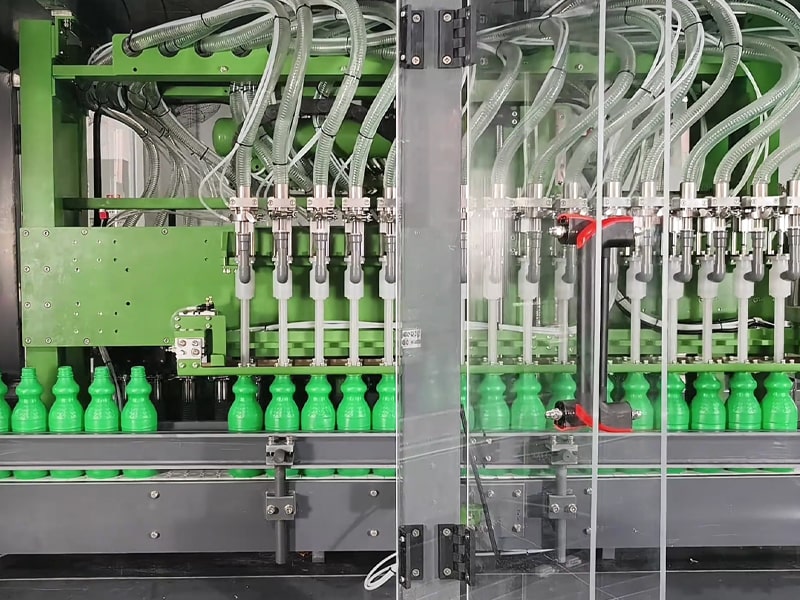
Customer Needs and Challenges
The customer – a major industrial cleaning products manufacturer – needed to boost output while maintaining product quality and safety. Their existing manual/blended process was a bottleneck. Key requirements included high throughput (6000 BPH at 1 L), full automation from infeed to palletizing, and 100% leak-free filling of bleach. Crucially, every wet-contact component had to withstand bleach’s highly oxidative nature. (Sodium hypochlorite solutions above 500 ppm chlorine are corrosive to many metals and plastics.) The customer had experienced rapid wear on previous fillers and valves. Downtime for maintenance, plus the need to avoid operator exposure, created a pressing need for a corrosion-resistant filling machine. They also required full system compliance with industrial hygiene and safety standards, including easy-clean surfaces and enclosed guarding. In summary, the project demanded a custom-designed, turnkey line that would dramatically improve efficiency and reliability for corrosive-liquid packaging.
Technical Overview of the Bleach Filling Production Line
The production line was modularly constructed with the following major components, each selected or customized for 6000 BPH (1 L bottles):
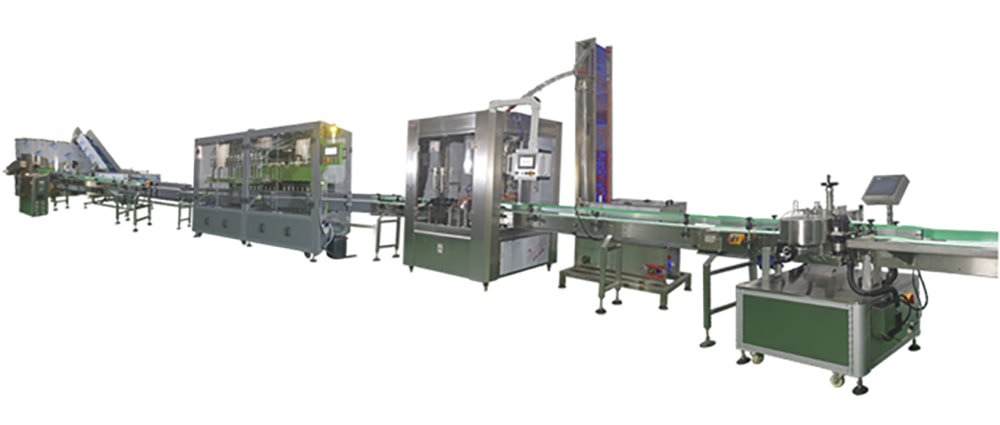 |
| Anti-Corrosion Bleach Filling Production Line |
 |
| Bleach Filling Production Line Equipments distribution 2D diagram |
- Bottle Unscrambler – A high-speed unscrambling infeed feeds empty bottles onto the conveyor. We provided an XBLP-series high-speed bottle unscrambler (model XBLP-150), which handles 300–1000 mL bottles at up to 150 bottles/min. Its PLC/HMI control and flexible infeed can handle different bottle shapes without tooling changes. The frame and conveyors are made of polished 304L stainless steel, providing structural strength and basic resistance to the ambient environment.
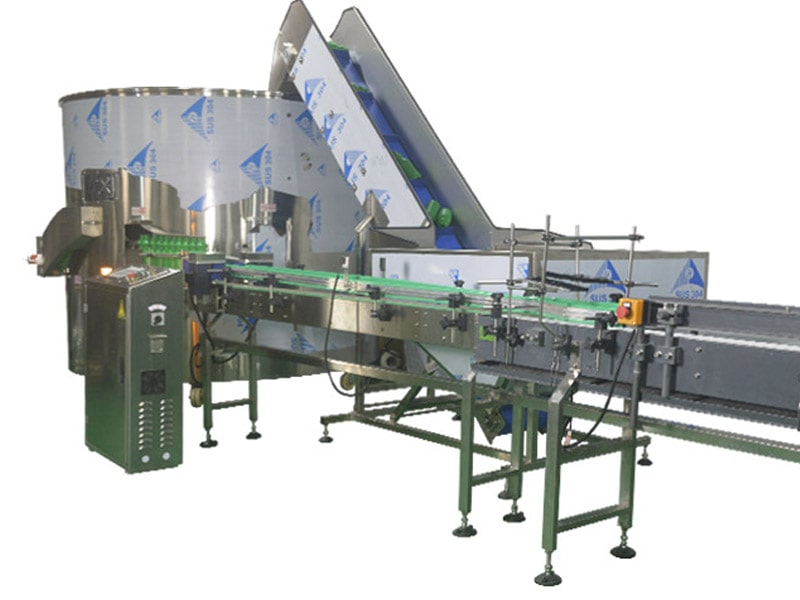 |
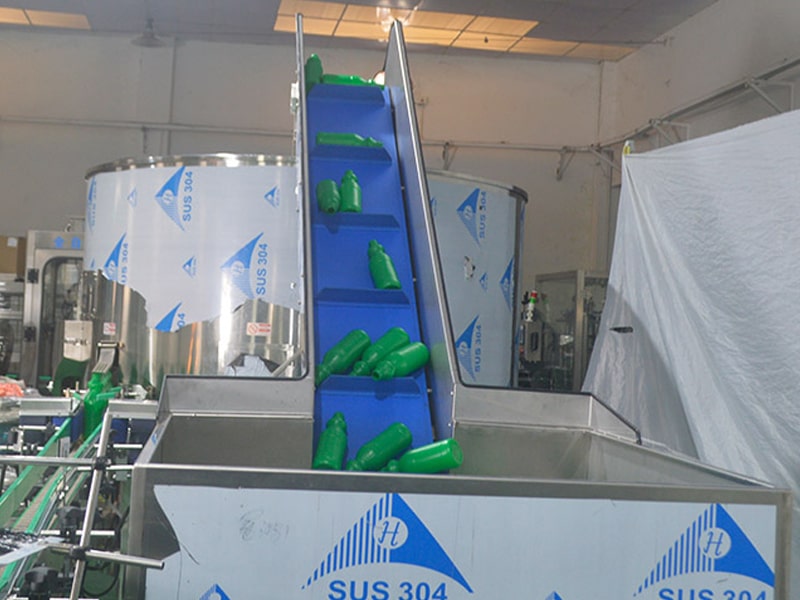 |
 |
| Bottle Unscrambler | ||
- Anti-Corrosion Filling Machine – The heart of the system is a 16-head gear-pump filler designed for corrosives. It uses an industrial gear pump driven by a servo motor for continuous, volumetric dosing. Each of the 16 nozzles fills 1 L bottles, synchronized to deliver 6000 bottles per hour. Filling is controlled by a Siemens PLC with touch-screen interface. Material compatibility is key: all wetted parts (pump block, valves and pipes) are PVDF/PVC/Teflon as described below, and the filler’s frame is stainless. A fail-safe “no bottle, no fill” sensor ensures no spillage. This 16-head configuration (customized from standard 10–12 head machines) was validated at factory test to reach the target 6000 BPH at ±1% accuracy. (For reference, similar gear-pump fillers for 1000 mL range reach 1000–10,000 BPH depending on head count.)
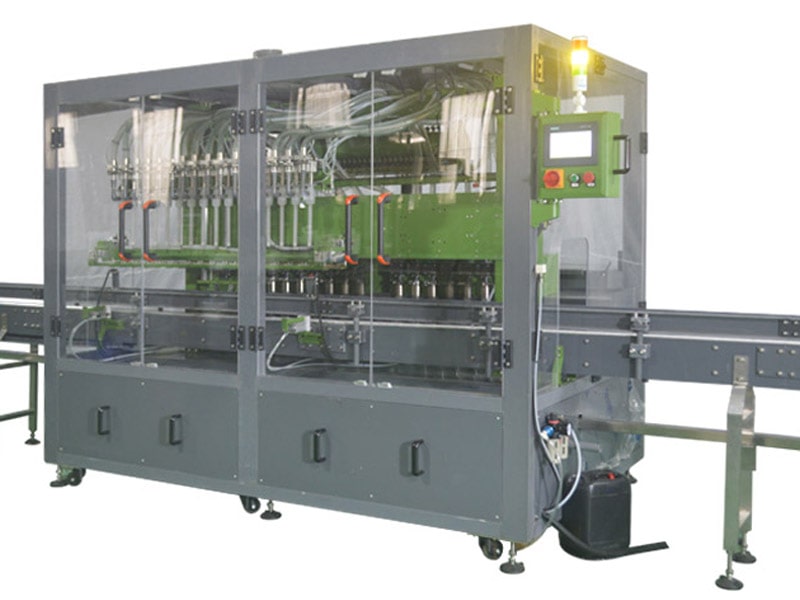 |
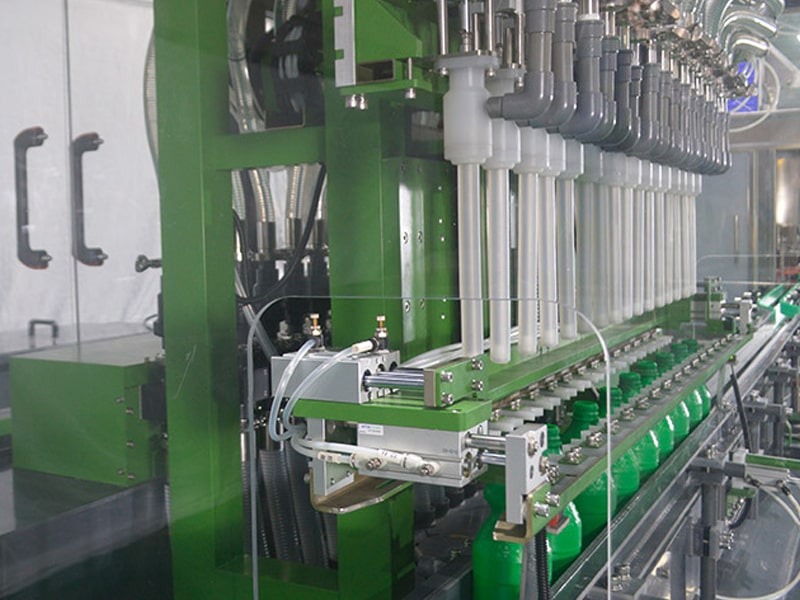 |
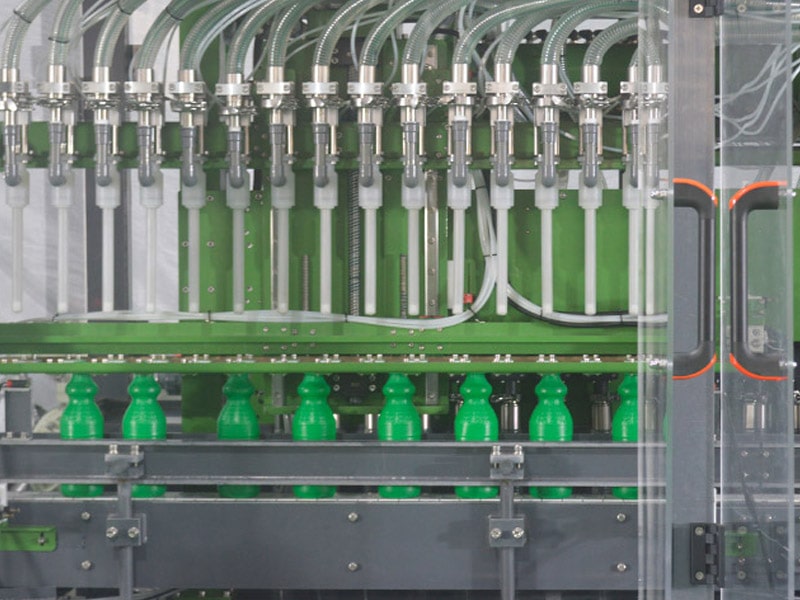 |
| Anti-Corrosion Filling Machine | ||
- Capping Machine – A rotary capper with six self-centering heads threads on caps at the required speed. The machine uses a vibration bowl feeder for caps, and a servo-driven torque control to avoid overtightening. With dual parallel capping spindles, it easily achieves 6000 BPH. Operators set torque and head heights via the control panel. The capper’s body is 304 stainless steel, with anodized aluminum and plastic parts for durability.
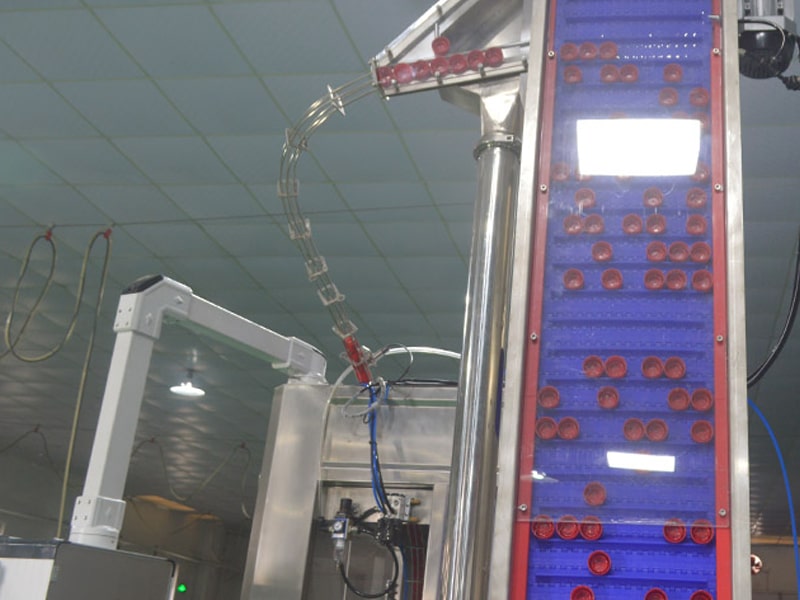 |
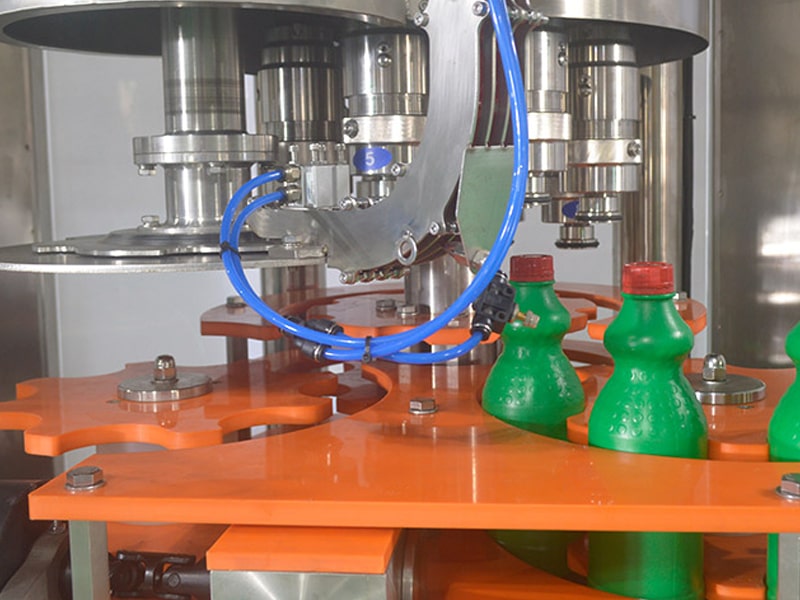 |
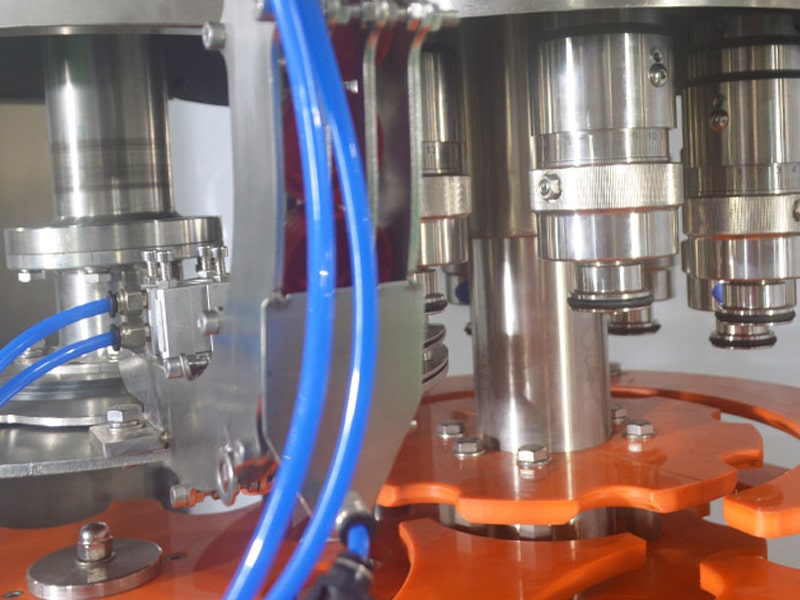 |
| Capping Machine | ||
- Labeling Machine – A single-side wraparound labeler applies pressure-sensitive labels. It runs at up to 6000 BPH using a servo drive and photo-eye registration. The label roll accommodates wide discs (up to 300 mm diameter) and label placement is accurate to ±1 mm. PLC-integrated sensors detect bottle position to trigger labeling precisely, and a tension-controlled unwind ensures flat labels. The design allows tool-free adjustments for different bottle diameters.
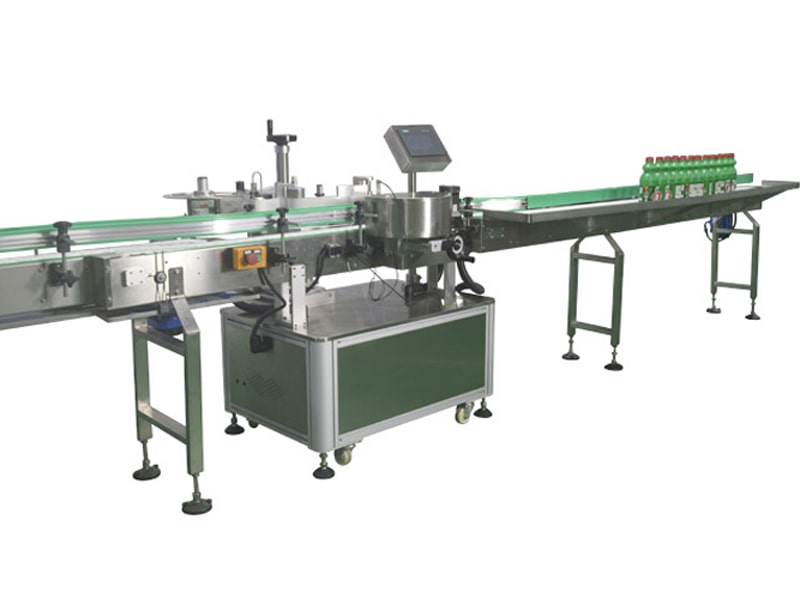 |
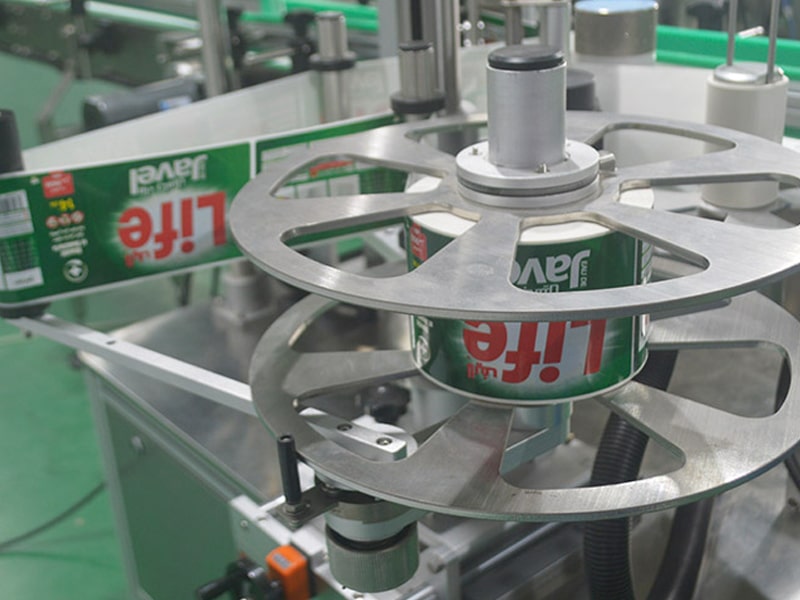 |
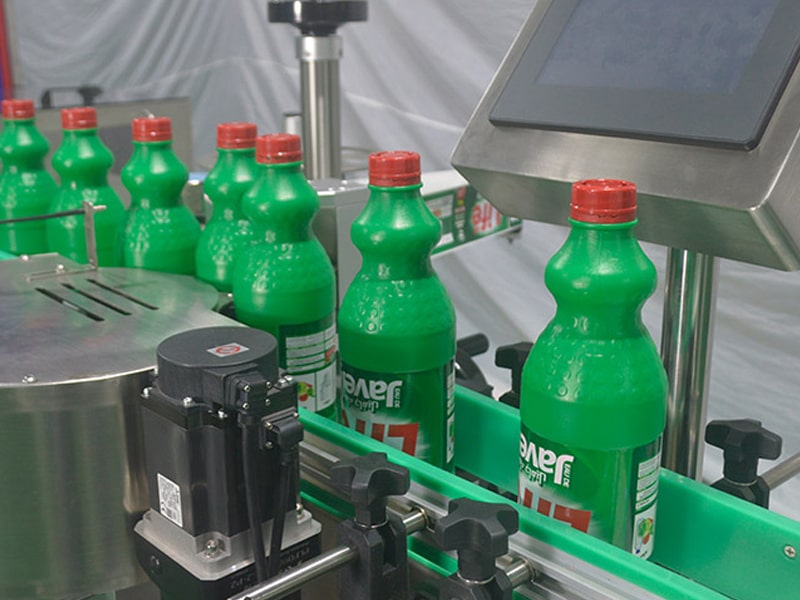 |
| Labeling Machine | ||
- Conveyor and Handling – Throughout the line, stainless-steel conveyors with PVC belts transport bottles between stations. The infeed conveyor has integrated bottle gates and starwheel indexing for the filler. After labeling, bottles move on a final outfeed conveyor and accumulation table for boxing or palletizing (the customer’s downstream process). All conveyors have adjustable height/speed and include stainless frames and protective guards to meet factory safety and hygiene requirements.
Each equipment’s key parameters are summarized below:
| Component | Model/Type | Capacity & Specs |
|---|---|---|
| Bottle Unscrambler | XBLP-150 high-speed | 300–1000 mL bottles; 15–150 BPM; 304L SS frame |
| Anti-Corrosion Filler | 16-head gear pump | Gear pump volumetric fill; 6000 BPH (1 L); ±1% accuracy |
| Capping Machine | 6-head rotary capper | 6000 BPH; servo torque control; bowl feeder |
| Labeling Machine | Servo labeler (1 side) | 6000 BPH; ±1 mm accuracy; PLC & photo-eyes |
| Conveyors (PPVC belt) | SS304 frame conveyors | IP65; PVC belt; speed 20–30 m/min; safety guarding |
High-speed, multi-head filling machine (right) integrating gear pumps and anti-corrosion components to fill bleach into 1 L bottles. All wet parts (pump, valves, nozzles) use corrosion-resistant materials.
Anti-Corrosion Engineering Features
Handling bleach safely was achieved through materials engineering and design:
- Material Selection: All wetted components are non-reactive. We used polyvinylidene fluoride (PVDF) or polypropylene (PP) pump blocks and valve blocks (PVDF is noted for excellent chemical resistance). Flexible tubing and gaskets are PTFE (Teflon), chosen for its inertness to oxidizers. The main filler tank and nozzles can be PVC or PP as well. In fact, industry designs specify PP for corrosives and avoid stainless steel. For example, the Landpack anti-corrosion filler uses PTFE feed tubes and a PVC/PP frame. (Our design also allows optional titanium nozzles if needed, since titanium is one of the few metals compatible with bleach.)
- Pump & Valve Design: A sealed gear pump handles the bleach continuously, minimizing shear and dead-volume. We fit Teflon-coated check valves and diaphragms. The inlet/outlet connectors are PVDF, and all joints use PTFE-lined fittings. The PLC-controlled valves have PTFE seals to prevent leaks. In summary, “no metal contact with bleach” ensures long life.
- Conveyors & Frames: Although the machine frames are SS304 for rigidity, all contact surfaces exposed to splash or vapors are coated or plastic. The conveyor belts themselves are PVC/PVDF, which resist chlorine. Stainless areas are finished to a smooth Ra≤0.8µm polish to allow easy cleaning and avoid traps for residues.
- Enclosure and Safety: The filler area is shrouded by polycarbonate guards, protecting operators from fumes. Drip trays under the filler and sealed cable glands isolate electrical parts. Our control panel is rated IP65 and located behind chemical-resistant covers. This hygienic design meets clean-in-place (CIP) standards for chemical processing equipment.
By combining plastics and fluoropolymers, the line achieves true anti-corrosion performance. PVDF and PTFE are standard in chemical plants for this reason. All sensors and actuators were chosen for compatibility (e.g. stainless or plastic housings). This ensures the system can run continuously with minimal maintenance in a bleach environment.
Turnkey Project Execution and On-Site Support
SFXB delivered this project as a turnkey solution, managing all phases:
- Engineering & Design: We began with detailed CAD layouts to fit the customer’s plant floor. The process flow, machine arrangement, and utilities (power, air, chemical lines) were specified. Our engineers handled the entire bill of materials and sourcing of long-lead items (PLC, motors, etc.). We created control schematics and HMI screens to match customer requirements.
- Factory Acceptance Testing (FAT): Prior to shipment, the complete line was assembled and tested at our workshop. We filled water and inert liquid in a mock-up run to verify speeds, accuracy and interlocks. The customer’s engineers attended via video to validate performance.
- Delivery & Installation: SFXB coordinated shipping and customs clearance. Our service team supervised installation and alignment at the customer’s plant. We provided on-site training so operators learned the HMI interface, cleaning procedures, and basic maintenance. The line was calibrated on bleach by our staff during commissioning.
- Start-up and Validation: Post-install, we ran the line with bleach and fine-tuned filler PLC recipes. We measured bottle weights and ensured caps and labels applied correctly at full speed. A small optimization period resolved any synchronization issues. The project was completed on schedule, with formal hand-over documents and user training.
- After-Sales Support: Consistent with industry best practice, we remain available for spare parts, troubleshooting, and future expansions. Spare pump modules, PLC backups, and consumable kits were provided. Our “complete solution” approach meant the customer had one point of contact from feasibility through commissioning.
Empty bleach bottles fed by the unscrambler (left) are indexed on the conveyor and spaced beneath the filler (center) for precise, leak-free dosing. PVC/PVDF materials protect against bleach.
Performance Outcomes and Benefits
The installed line rapidly met and exceeded expectations. Key outcomes included:
- Production Efficiency: The line reliably achieved 6000 BPH at 1 L, a throughput improvement of over 3× compared to the previous manual line. Continuous automatic operation eliminated downtime between shifts. Changeovers between bottle sizes (1.0L to 0.75L) now take under 15 minutes, thanks to the PLC recipe memory.
- Consistency & Accuracy: Volumetric filling delivered ±0.5% precision on weight (well within spec). Automatic “no-bottle, no-fill” logic prevented any spills, maximizing product yield. Capping torque sensors ensured every cap is tight without damage, and labels have held position through handling.
- Ease of Operation: Operators found the touchscreen interface intuitive. One PLC recipe covers all setpoints; adjusting fill volume is a few taps on the HMI. The system has automated CIP (cycle-on-demand cleaning) built in, enabling quick clean-outs without disassembly. In short, the line runs essentially unattended, with one operator per shift overseeing quality.
- Corrosion Resistance and Uptime: There have been no corrosion issues in the first operating year. Weekly inspections confirmed that PVDF/PTFE wetted parts show no signs of wear. In contrast to past experience, maintenance intervals have lengthened; only routine greasing of servo motors and air filters was needed. This reliability has improved overall equipment effectiveness (OEE) significantly.
- Safety and Compliance: The enclosed filler and robust guarding protect workers from chemical exposure. Emergency stops at multiple stations give added safety. The stainless and plastic surfaces meet food/pharma clean standards, and the customer has passed internal audits for chemical plant hygiene.
- Customer Feedback: The client reports dramatically higher output with lower labor. One production manager noted: “This system runs like clockwork and is easy to clean. We no longer worry about bleeding hoses or metal corrosion – it’s built exactly for bleach.” Such feedback underscores the solution’s fit.
Overall, the investment yielded a rapid return via higher throughput, lower waste and safer operation. The turnkey implementation meant the customer could ramp up production almost immediately without internal design effort.
Why Choose SFXB Packaging Machinery
Customers choose SFXB because of our experience, expertise and end-to-end service. SFXB (XueBa) specializes in automated liquid filling lines, with a reputation for custom, non-standard solutions. Our strengths include:
- Deep Industry Know-How: We have years of experience designing chemical packaging lines, from acids to detergents. We understand the challenges of corrosive fluids and hazardous materials.
- Custom Turnkey Solutions: Every line is engineered to client requirements. We handle design, fabrication, controls programming, and project management. As one industry partner puts it, we provide “complete solutions” including procurement, delivery, installation and training.
- Technical Excellence: Our engineers use state-of-the-art modeling and hygienic design practices. We integrate certified components (Siemens/Schneider PLCs, Panasonic servos, etc.) and follow strict quality protocols to ensure reliability.
- Global Support: Though based in Guangzhou, we support international clients with English-speaking teams, online commissioning, and timely spare parts. Many past case studies (from beverage to pharma) attest to our authority in the field.
- After-Sales Service: We stand behind our systems with training and spares. Users have access to lifetime tech support and documentation. This commitment builds trust – customers know we’ll keep their line running year after year.
In summary, SFXB’s unique combination of skilled engineering and responsive service makes us a trusted partner for specialized filling lines.
Conclusion
This custom 6000 BPH bleach filling line demonstrates how targeted engineering solves a demanding packaging challenge. By using corrosion-proof materials and precision machinery, we achieved high-speed, drip-free filling of sodium hypochlorite – a feat unachievable with off-the-shelf equipment. The result is a safe, efficient production line that delivers consistent 1 L bleach bottles at industrial scale. Thanks to the turnkey approach, the customer gained a fully validated system with minimal effort. This case exemplifies how SFXB’s expertise translates into reliable results for corrosive-liquid packaging. We stand ready to design similar turnkey filling systems for any high-demand chemical application, backed by our proven track record and engineering excellence.
Frequently Asked Questions (FAQ) About Bleach Filling Line
1. What is a bleach filling machine?
A bleach filling machine is specialized equipment designed to accurately dispense sodium hypochlorite (bleach) into containers, using corrosion-resistant materials like PVC, PVDF, and PTFE. These materials prevent chemical degradation and ensure safe, leak-free operation.
2. Why is anti-corrosion filling necessary for bleach?
Bleach is highly oxidative and chemically harsh. Regular metals like stainless steel can corrode quickly on contact. Anti-corrosion fillers use inert plastics and fluoropolymers (PVDF/PVC/PTFE) to protect pump blocks, valves, and nozzles, ensuring longevity and safety.
3. How fast can the 6000 BPH 1L line operate?
The line achieves 6000 bottles per hour (about 100 bottles per minute) thanks to a 16‑head gear‑pump filler, high-speed unscrambler, rotary capper, and servo-driven labeler—making it ideal for high-volume bleach production.
4. What equipment is included in the full filling production line?
The turnkey filling production line includes:
● High-speed bottle unscrambler
● 16‑head anti‑corrosion bleach filler
● Rotary capping machine
● Servo labeler
● PVC/304 stainless-steel conveyors
● HMI/PLC controls
● Enclosed guarding and CIP capability for safe, hygienic operation
5. What are the main benefits of anti-corrosion engineering features?
Anti-corrosion design ensures:
● Extended uptime—materials resist harsh bleach
● No leaks or spillage—improved yield
● Cleaner components—smooth surfaces and CIP-friendly design
● Enhanced operator safety—enclosed systems reduce exposure
6. Does this line provide turnkey installation and support?
Yes—SFXB provides complete turnkey service, covering design, engineering, factory FAT, global shipping, on-site installation, commissioning, operator training, and long-term after-sales support.
7. How accurate is the bleach filling process?
The gear-pump filler offers volumetric accuracy of ±1%. A “no-bottle, no-fill” system prevents waste, while torque-controlled capping and ±1 mm label accuracy assure consistent quality.
8. Is changeover between bottle sizes easy?
Bottle changeovers (e.g., from 1 L to 0.75 L) take under 15 minutes. The PLC/HMI recipe system allows one-touch adjustments for volume, head count, and line speed.
9. What maintenance does the line require?
Maintenance is minimal. Most non-wetting parts are standard; only PTFE/PVDF wetted components and PVC conveyors contact bleach. Routine tasks include servo motor lubrication, filter changes, and periodic inspection—no corrosion-related repairs.
10. Is the system safe and compliant for chemical production?
Absolutely. The line meets industry hygiene and safety standards with:
● Enclosed filler area
● IP65-rated control panels
● Safety interlocks & EM stops
● Smooth 304 stainless frames and guards to facilitate cleaning and pass plant audits


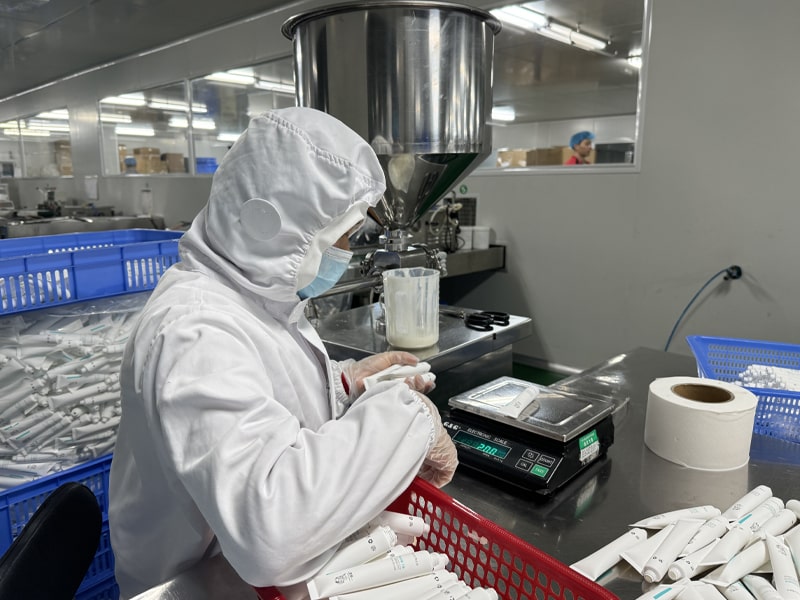
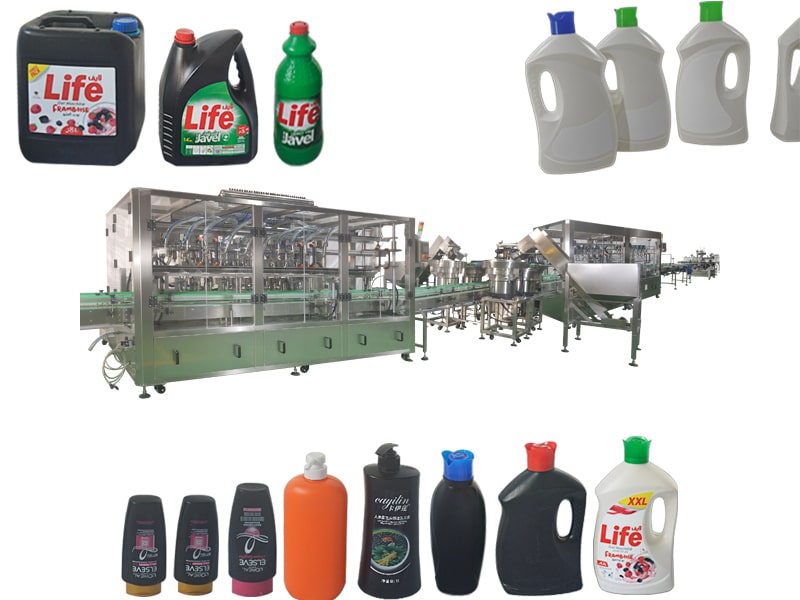

Comments